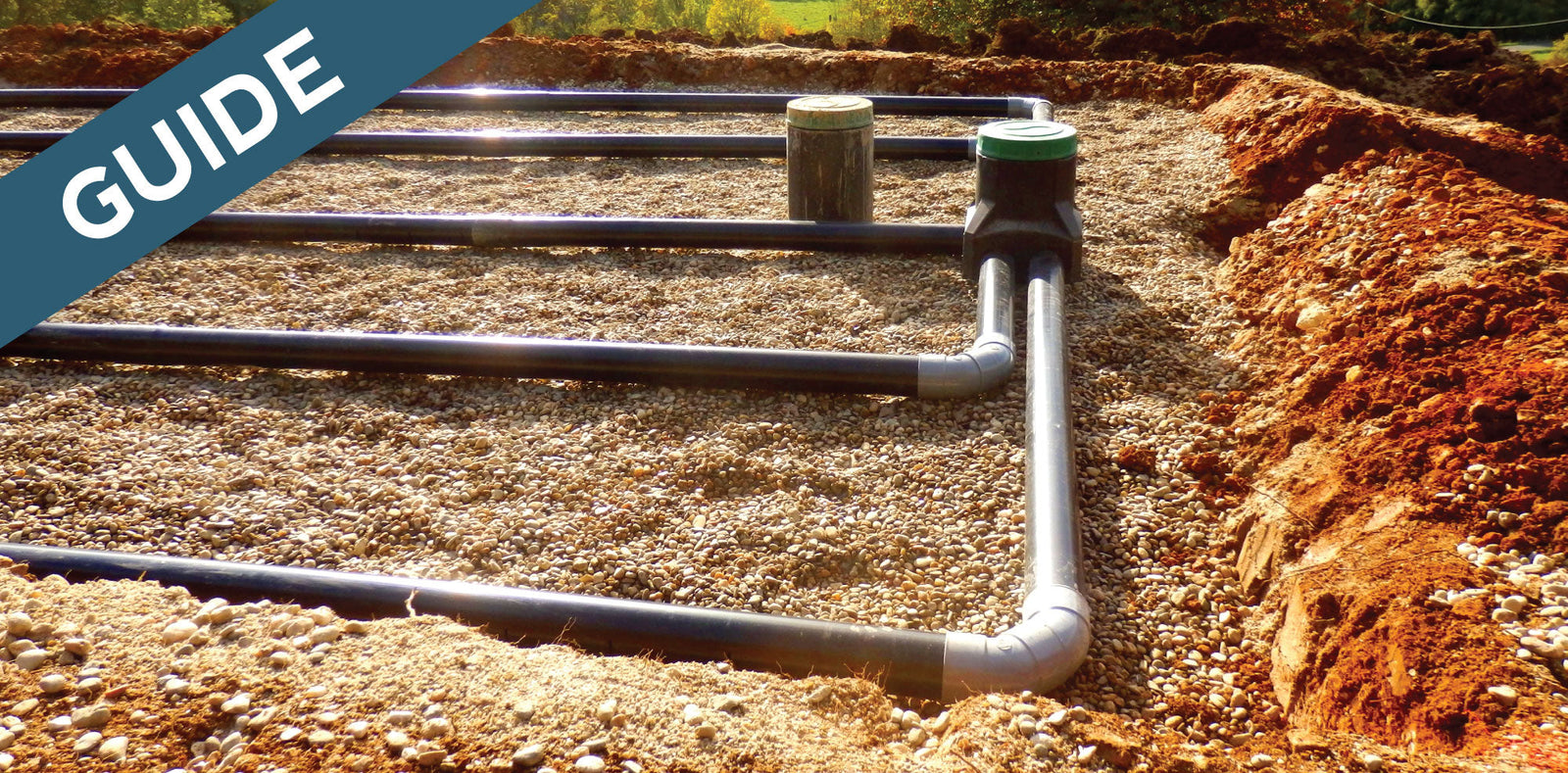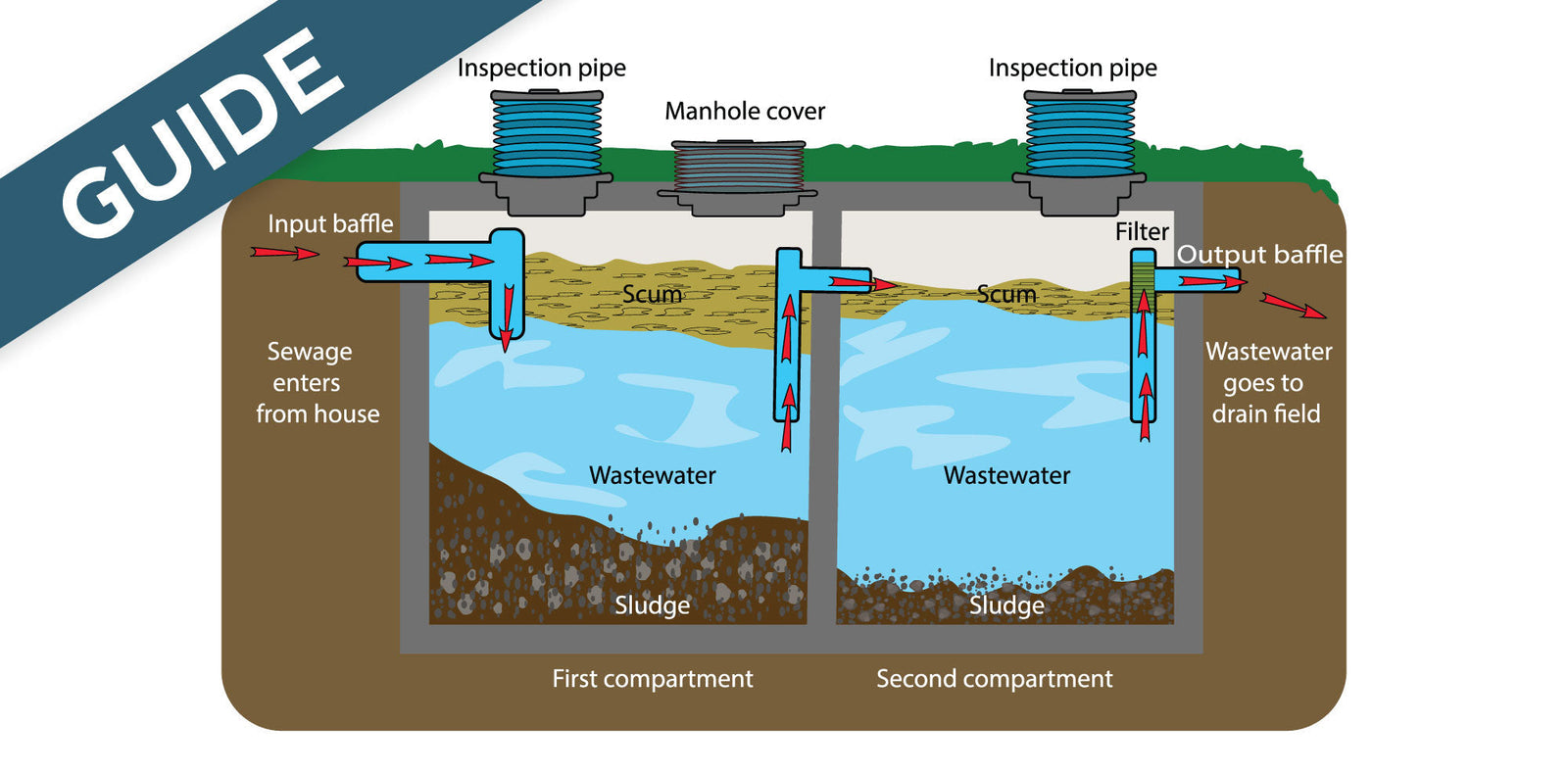Key Points:
- There are many types of septic systems, including 1) conventional systems, 2) chamber systems, 3) drip distribution systems, 4) aerobic treatment systems, 5) mound systems, 6) recirculating sand filter systems, 7) evapotranspiration systems, 8) constructed wetland systems, and 9) community systems.
- Most homes have a conventional septic system, which consists of a septic tank where waste is broken down and a leach field where water is dispersed back into the ground.
- A chamber system replaces a traditional leach field with several compartments that treat wastewater.
- A drip distribution system uses a pump to perfectly time the rate at which wastewater passes into the drain field.
- An aerobic treatment system infuses a septic chamber with oxygen, helping to speed up the breakdown process by facilitating the growth of natural bacteria.
- A mound system is an alternative to a traditional buried leach field. In this system, a mound of soil is built over the drain field pipes, and wastewater passes through a layer of sand that helps to process waste.
- A recirculating sand filter system filters wastewater through a compartment filled with sand and recirculates the water until it's clear of solid waste.
- An evapotranspiration system seals wastewater from entering the ground. Instead, it forces waste water to evaporate upwards.
- A constructed wetland system processes wastewater in a wetland, allowing additional water to percolate into the ground.
- A community system consists of many homes (with separate septic tanks) connected to one drain field.
As with most things, there are many options to choose from when it comes to septic systems! Whether you are looking to install a new septic system for your home, replace an old one, learn which type is already installed for your home, or just become more informed about the different types of septic systems out there, this article should benefit you greatly. We’ll dive into each type of septic system in turn, giving an overview and examining the pros and cons of each!
Conventional Septic System
A conventional septic system is what you would typically find installed in a modern home. At its most basic level, a conventional septic system consists of a septic tank and a drain field (more commonly called a "leach field"). Waste is broken down in the septic tank by bacteria, and the liquid separates from the solids, which settle to the bottom. The liquid then flows out of the septic tank and into the drain field and is safely absorbed back into the ground.
Pros:
- This system is dedicated to your property, giving you more control over the system.
- It's environmentally safe.
- It can last for many years. With proper maintenance, some sources say that a traditional septic system can last for upwards of 40 years!
- If properly maintained, a conventional septic system can be very cost effective. When compared to installing municipal sewage pipes or paying monthly city-mandated fees, a conventional system may be significantly cheaper!
Cons:
- This system typically requires a large plot of land. Because of the size of the leach field, a conventional system may not fit in a smaller lot.
- The septic tank or leach field (or both!) will eventually need to be replaced, and this can be quite expensive.
- If not properly maintained, a conventional septic system can be expensive to repair. If the system is not pumped regularly or properly maintained using the right care habits, you will be faced with clogs, backups, and nasty odors—which ultimately means costly repairs!
- You must be conscientious about your water usage. Because the system takes time to break down waste and disperse wastewater into the leach field, using too much water can overload the system and lead to malfunctions.
- You must be proactive in only allowing certain items to enter your septic tank (human waste and toilet paper). Nothing else should be allowed into your system, because it will lead to clogs.
Chamber Septic System
A chamber septic system is very similar to a conventional septic system. Both types use a septic tank. However, the main difference is found in the construction of the leach field. Whereas a conventional system uses a lateral line system (i.e., a network of perforated PVC pipes that allow water to filter into the surrounding soil), a chamber system uses larger chambers (normally larger sized pipes) that are buried under the ground. Also, while a conventional system uses gravel around the PVC pipes of the leach field, a chamber system is gravel-less. In a chamber system, water from the septic tank flows into several chambers, where it comes into contact with the surrounding soil and is treated by microbes near the soil. After this, like a conventional system, a chamber system allows the wastewater to disperse safely into the ground.
Pros:
- It's somewhat easier to deliver the materials and construct a chamber septic system.
- A chamber system can reduce your carbon footprint, because you can use recycled materials.
- This system works well in areas with higher water tables.
- It's safe for the environment.
- The system can last for many years.
Cons:
- Like a conventional system, this system requires a larger plot of land.
- You must have the proper type of soil on your property for a chamber system to function efficiently.
- If the water table is shallow on your property, this system may not work. For a chamber system to function properly, soil percolation rates must be between 0.2 and 2.4 minutes per millimeter.
Drip Distribution System
Like the previous two septic systems, a drip distribution septic system continues to use a normal septic tank. However, instead of lateral lines or chambers, a drip distribution system uses pipes that allow only a small amount of liquid from the septic tank to disperse into the ground at a given time, meaning that water is distributed more evenly.
Pros:
- This system works well on sites with slow draining soil.
- Because the pipes are normally only buried in 6-12 inches of soil, they are easier to install and no large mound is required.
Cons:
- In order to precisely time the distribution of water into the soil, this system requires a large dose tank that must be installed between the septic tank and the drain field.
- The system requires electricity to time doses, which can mean more expense and more maintenance.
Aerobic Treatment System
The aerobic system (commonly referred to as aerobic septic systems) is the first example on our list that does not use a traditional septic tank. Instead, this system replaces the septic tank with an Aerobic Treatment Unit (ATU). Oxygen is infused into the ATU, which increases the activity of naturally occurring bacteria. This, in turn, increases waste breakdown and provides additional treatment for the wastewater moving out of the tank.
Pros:
- Because of increased bacteria activity, this system is efficient and works quickly.
- Due to increased efficiency, water discharged from the system into the leach field is generally cleaner and therefore easier to treat.
- Due to cleaner and more efficient wastewater treatment, this system is better for the environment.
- Because of its compact design, this system often works better on smaller lots.
Cons:
- Because it's more complex, this system is typically more expensive to install.
- An aeration unit (to add oxygen to the system) is also required, which again means more cost.
- The system requires more maintenance.
Mound System
A mound system again uses a septic tank; however, instead of a traditional leach field, this system builds a mound of soil over the drain field pipes rather than burying them. Water from the septic tank flows into a pump chamber which pumps wastewater up into the mound at the correct rate. After this, wastewater is treated when it flows out of the pipes in the mound and through a layer of sand, after which it disperses into the surrounding soil.
Pros:
- This system works well in areas that have shallow soil or especially high water tables because you don't have to bury your lateral lines.
- The system keeps wastewater away from the water table.
Cons:
- A mound system requires an especially large amount of space.
- This system requires more maintenance.
- There is the extra cost of installing a pump.
- Because the system is so close to the surface, there is an increased possibility of nasty smells.
- Produces an unsightly mound of soil!
Recirculating Sand Filter System
A sand filter system functions much like a mound system in that it uses sand to filter wastewater. But with that said, instead of a mound, a recirculating sand filter system pumps wastewater from the septic tank into a sand filter compartment (normally made of concrete), which is located either above or below the ground. This sand filter compartment is (as you might have guessed) filled with sand. Wastewater is treated as it passes through the sand. It then leaves the system, passing into the drain field. Additionally, both already-filtered and new wastewater passes through another compartment—the recirculation tank—where it's further processed.
Pros:
- This system works well on sites with high water tables or nearby bodies of water.
- Sand filters provide an effective method for treating wastewater—removing up to 95% of impurities.
- The system can be installed on smaller plots of land.
Cons:
- Because the system is more complicated and has more components, it can be significantly more expensive.
- Regular (weekly) maintenance is required.
- This system does not tend to work well in colder temperatures.
Evapotranspiration System
While its name makes it sound complicated, an evapotranspiration system actually only reverses the normal way a septic drain field works. The system still uses a traditional septic tank (as most of these alternative systems do), but when wastewater passes out of the tank, it enters an evapotranspiration bed—a compartment containing sand and gravel that is entirely sealed on the bottom, preventing water from seeping into the ground. The evapotranspiration bed is covered with vegetation. Plants use the water in the bed, and any additional moisture makes its way to the surface and evaporates into the air.
Pros:
- Because this system does not allow wastewater to enter the ground, it works well in areas with high water tables or where the risk of contaminating the surrounding ground water is high.
- The cost of this system is comparable to more traditional systems.
Cons:
- This system only works in arid areas where evapotranspiration rates exceed annual rainfall by at least 24 inches.
- The storage capacity of the evapotranspiration bed is very limited.
- Rainfall or other precipitation can overload the system.
- The bed liner can leak if not properly sealed—effectively defeating the purpose of the system.
Constructed Wetland System
A constructed wetland septic system attempts to manually mimic the way an actual wetland functions. Wastewater moves from the septic tank into a wetland area, typically lined with a waterproof material and containing sand and gravel. The wastewater is treated by plants and microbes. Any additional wastewater is then dispersed into the ground via the drain field.
Pros:
- This system treats wastewater very effectively.
- It's relatively cheap.
- It's easy to maintain.
Cons:
- This system requires a large amount of space (to construct a wetland).
- A wetland might not be a great option in colder environments.
- The wetland can attract animals and pests.
Community System
A community system is exactly how it sounds. It consists of multiple houses (each usually possessing its own septic tank) connected to one drain field. Rural subdivisions commonly have community septic systems.
Pros:
- Maintenance can be dispersed over many people (if so desired).
Cons:
- You have less personal control over your own system.
- The system requires an especially large plot of land to accommodate the community drain field.
Conclusion
All things considered, you should choose the type of septic system that best fits with your particular needs and desires. We hope that this article has helped you to determine what type of septic system is best for you! Keep in mind that many of these types of septic systems (not all) are improved when used in conjunction with a bacterial septic system treatment. We always recommend our product Septic System Digester for the best results!
If you have any further questions or concerns about this topic, please feel free to contact us at support@uniquemm.com. We would love to answer your questions!





